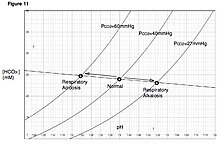
Back حماض تنفسي Arabic Respiratorische Azidose German Acidosis respiratoria Spanish اسیدوز تنفسی Persian Acidose respiratoire French Acidose respiratoria Galician Asidosis respiratorik ID Acidosi respiratoria Italian 呼吸性アシドーシス Japanese 호흡성 산증 Korean
| Respiratory acidosis | |
|---|---|
 | |
| Davenport diagram | |
| Specialty | Intensive care medicine, pulmonology, internal medicine |
Respiratory acidosis is a state in which decreased ventilation (hypoventilation) increases the concentration of carbon dioxide in the blood and decreases the blood's pH (a condition generally called acidosis).
Carbon dioxide is produced continuously as the body's cells respire, and this CO2 will accumulate rapidly if the lungs do not adequately expel it through alveolar ventilation. Alveolar hypoventilation thus leads to an increased PaCO2 (a condition called hypercapnia). The increase in PaCO2 in turn decreases the HCO−3/PaCO2 ratio and decreases pH.